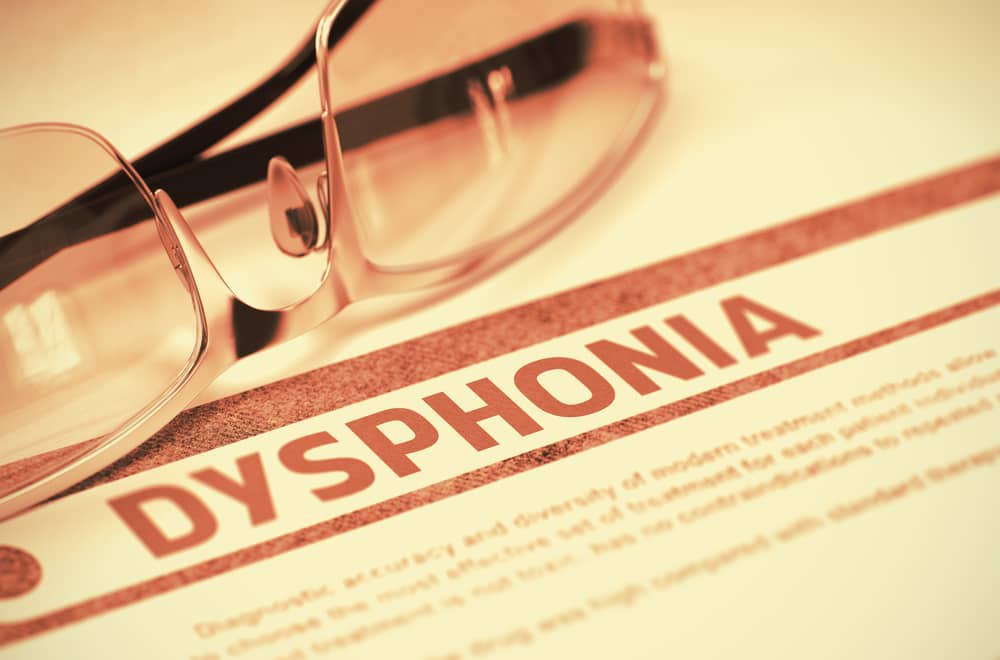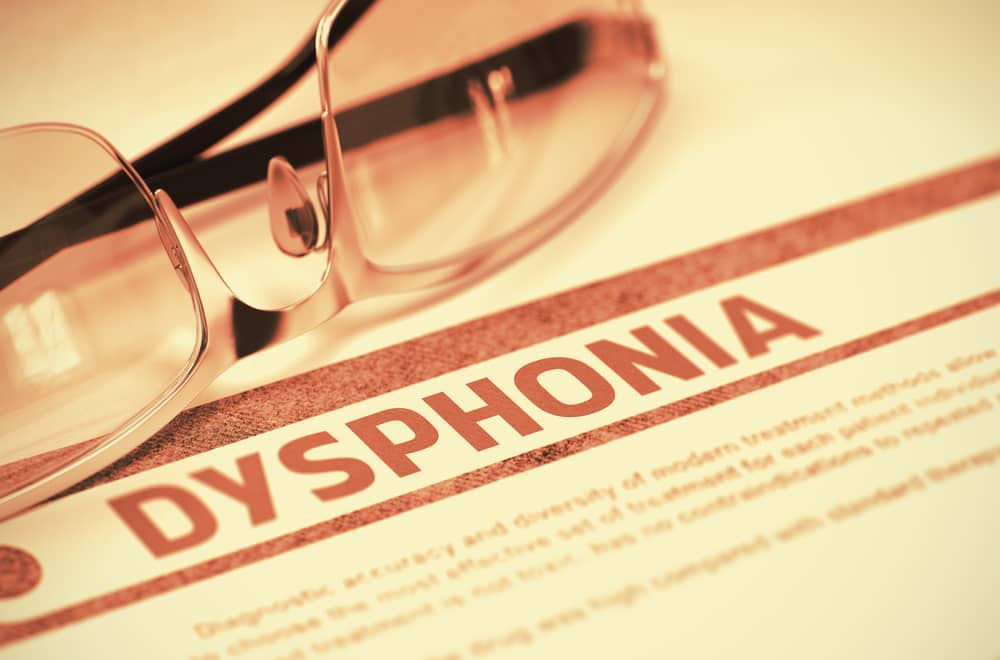What is Spasmodic Dysphonia? (Symptoms, Causes, and Treatment)
May 2nd, 2020 | 4 min. read


Spasmodic dysphonia (SD) is defined as a voice disorder. It leads to involuntary spasms in your larynx or voice box muscles. It causes your voice to break and have a strained, tight or strangled sound.
Spasmodic dysphonia can lead to issues that range from having difficulty saying one or two words to not having the ability to talk at all. It's a life-long condition, often affecting women (usually between 30 and 50 years old) more than men.
Spasmodic Dysphonia Types
Spasmodic Dysphonia comes in three forms:
1. Adductor Spasmodic Dysphonia:
This form of SD is the most common. It leads to involuntary and sudden spasms that cause your vocal cords to become stiff and shut closed. These spasms disrupt your vocal cord's vibration and sound making. Stress can worsen the spasms. Your speech sounds become strained. Spams don't occur when you:
-
Laugh
-
Whisper
-
Speak at a high pitch
-
Sing
-
Speak while you breathe in
2. Abductor Spasmodic Dysphonia:
This form leads to sudden involuntary spasms that cause the opening of your vocal cords. When your cords are open, vibration can't happen so it's difficult to make a sound. Also, air escapes while you talk in this open position. Your speech sounds quiet, weak and whispery. Spasms don't occur when singing or laughing.
3. Mixed Spasmodic Dysphonia:
This form is a combination of symptoms of both the other two dysphonia types.
Spasmodic Dysphonia Symptoms
The primary symptom of this condition is an involuntary spasm or movement of your muscles inside your vocal cords, which strains your speech. You might drag out your words or they might become interrupted while you're talking.
You might also sound:
-
Like you can't get enough air while speaking
-
Like you have too much air behind the words you speak
With this condition, you often start by experiencing infrequent mild symptoms. But, as the condition progresses, it might be hard to understand your speech. Each word you speak or every other word might be impacted by a muscle spasm.
This progression often stops after about a year or so, which stabilizes your symptoms.
Spasmodic Dysphonia Causes
There's no known cause of SD. Since your voice can sound almost normal or normal at times, the condition was once believed to be psychogenic or that it originated from the individual's mind instead of due to a physical cause. Psychogenic spasmodic dysphonia forms do exist in rare cases, but typically it's muscle spasms caused by irregularities in your brain or central nervous system.
It’s not expected that spasmodic Dysphonia will shorten an individual’s life span. For some individuals, the symptoms of this condition might affect communication with others, and this can impact the quality of life in both social and work situations.
Spasmodic dysphonia might co-occur with another type of dystonia that causes repetitious and involuntary movement of muscles as the:
-
Face
-
Eyes
-
Arms
-
Legs
-
Body
-
Lips
-
Jaws
-
Neck
-
Tongue
It's thought spasmodic dysphonia is caused by irregular functioning of your basal ganglia (an area of your brain). Your basal ganglia consist of a few clusters of nerve cells that are deep inside your brain. Your basal ganglia help coordinate muscle movements throughout your body. Research has recently found irregularities in other areas of your brain, which includes your brain stem. This is the stalk-looking stem of your brain connected to your spinal cord.
Sometimes, spasmodic dysphonia might run in families. While 14 genes have been linked recently with a variety of dystonias, only mutations in the THAP1 gene have been linked with whole-body dystonia forms that start in childhood and that could show up with Spasmodic Dysphonia. But, this genetic defect doesn't appear to be linked with the more common focal Spasmodic Dysphonia form that starts in adults.
Spasmodic Dysphonia Diagnosis
You likely want to know how is Spasmodic Dysphonia diagnosed. There's no certain test for diagnosing spasmodic dysphonia. A spasmodic dysphonia diagnosis is based on your description of the symptoms you're experiencing, how your voice sounds and the speech-language pathologist's and laryngologist's observation of your vocal folds while you're speaking.
1. Patient History
Because there's no specific test for diagnosing Spasmodic Dysphonia, the description of the voice disorder onset and symptoms is extremely important for a diagnosis.
2. Speech-Language Pathology Evaluation
Also important is the pattern of voice breaks in identifying Spasmodic Dysphonia and planning treatment. Your speech pathologist is experienced and trained in listening and evaluating for these various speech and voice patterns. As part of your physical exam, you might be asked to repeat specific phrases designed for bringing out voice breaks. Aerodynamic and acoustic measurements might also be used for evaluating voice characteristics.
3. Laryngoscopy
While you speak, your ENT doctor might visualize your vocal folds through laryngoscopy to see the spasm behaviors characteristic of the condition.
4. Neurologic Evaluation
You might be asked about linked neurologic symptoms like tremor or weakness and about certain medication or drug use that have been linked with movement disorders. These include:
-
Neuroleptic medicines
-
Psychotic medicines
-
Illegal intravenous drugs
Since spasmodic dysphonia is a central nervous system disorder, your examination should also include a thorough neurologic exam. Some otolaryngologists may ask you to see a neurologist for this examination.
Spasmodic Dysphonia Treatment
While there's no cure for spasmodic dysphonia, there are available treatments that can help ease your symptoms.
Several factors will determine your next steps of treatment, including your:
-
Overall health
-
Age
-
Condition severity
Your ability to handle specific procedures like surgery is also evaluated. How you feel about treatment is essential too. Vocal cord surgery does carry some risk of permanent damage.
Voice Therapy
In many situations, voice or speech therapy is recommended over surgery. Therapy teaches you how to correct your breathing and improve your muscle control, which can help you speak better and more clearly.
Botox
Your doctor might also suggest regular Botox (botulinum toxin) injections into your affected muscles. Botox is the same material used in cosmetic treatments to provide your face with a younger appearance.
In individuals with spasmodic dysphonia, Botox blocks muscle nerve signals, helping to prevent spasms. But, the treatment's effects are temporary. Your symptoms will likely come back after several months, so you'll need to repeat treatment to maintain the effects.
Surgery
Surgery on one of your vocal cords nerves isn't a common procedure, but it has been done for this rare condition.
Lifestyle Adjustments
It can be challenging having to live with spasmodic dysphonia, particularly if you have a job that requires you to speak frequently. There is technology available to help you communicate more clearly. You'll find phone devices for amplifying your voice. Software for handheld devices or computers is available for serious cases that translates text into artificial speech.
Ongoing Research Into Spasmodic Dysphonia
There's ongoing research into the treatments and causes of spasmodic dysphonia. Clinicians and scientists are working to learn and understand the causes of this condition. They’re also trying to find the underlying way in which it develops. Researchers use brain imaging studies to help them identify potential differences between individuals with the condition and healthy volunteers.
While there aren’t any animal models available currently for studying spasmodic dysphonia, there are a few that have been developed for studying other types of dystonia. If researchers identify a suitable animal model, they’ll have a new tool for exploring spasmodic dysphonia’s underlying cause and for testing new treatments.
Contact Houston Voice and Swallowing Center for Spasmodic Dysphonia Evaluation and Treatment
For a Spasmodic Dysphonia Evaluation, call us at 281-649-7000 or complete our online form. We now have telemedicine appointments as well.
Click the button below to go to our Houston Voice and Swallowing Center page.
Topics:
